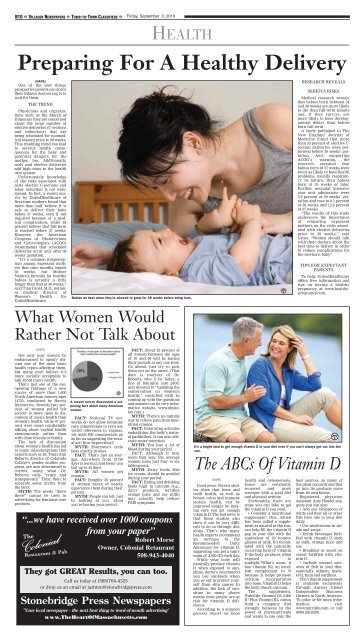Putnam - Southbridge Evening News
Putnam - Southbridge Evening News
Putnam - Southbridge Evening News
Create successful ePaper yourself
Turn your PDF publications into a flip-book with our unique Google optimized e-Paper software.
B10 ☎ VILLAGER NEWSPAPERS ☎ TOWN-TO-TOWN CLASSIFIEDS ☎ Friday, September 3, 2010<br />
HEALTH<br />
Preparing For A Healthy Delivery<br />
(NAPS)<br />
One of the best things<br />
prospective parents can do for<br />
their infants, doctors say, is to<br />
wait for them.<br />
THE TREND<br />
Physicians and organizations<br />
such as the March of<br />
Dimes say they are concerned<br />
about the large number of<br />
elective deliveries (C-sections<br />
and inductions) that are<br />
being scheduled for nonmedical<br />
reasons prior to 39 weeks.<br />
This troubling trend can lead<br />
to serious health consequences<br />
for the baby and<br />
potential dangers for the<br />
mother, too. Additionally,<br />
early and elective deliveries<br />
add high costs to the health<br />
care system.<br />
Unfortunately, knowledge<br />
of the risks associated with<br />
early elective C-sections and<br />
labor induction is not widespread.<br />
In fact, a recent survey<br />
by UnitedHealthcare of<br />
first-time mothers found that<br />
more than half believe it is<br />
safe to deliver their baby<br />
before 37 weeks, even if not<br />
required because of a medical<br />
complication, while 24<br />
percent believe that full term<br />
is reached before 37 weeks.<br />
However, the American<br />
Congress of Obstetricians<br />
and Gynecologists (ACOG)<br />
recommends that scheduled<br />
deliveries occur only after 39<br />
weeks’ gestation.<br />
“It’s a common misperception<br />
among expectant mothers<br />
that nine months equals<br />
36 weeks, but Mother<br />
Nature’s formula for healthy<br />
babies is actually a little<br />
longer than that at 40 weeks,”<br />
said Tina Groat, M.D., national<br />
medical director of<br />
Women’s Health for<br />
UnitedHealthcare.<br />
Babies do best when they’re allowed to grow for 39 weeks before being born.<br />
RESEARCH REVEALS<br />
SERIOUS RISKS<br />
Medical research reveals<br />
that babies born between 34<br />
and 36 weeks are more likely<br />
to die than full-term infants<br />
and, if they survive, are<br />
more likely to have developmental<br />
delays than babies<br />
born full term.<br />
A study published in The<br />
New England Journal of<br />
Medicine found that more<br />
than 35 percent of elective C-<br />
section deliveries were performed<br />
before 39 weeks’ gestation.<br />
And, supporting<br />
ACOG’s warning, the<br />
research revealed that<br />
babies born at 37 weeks were<br />
twice as likely to have health<br />
problems, usually respiratory<br />
in nature, than babies<br />
born at 39 weeks or later.<br />
Further, neonatal intensive<br />
care unit admissions were<br />
5.9 percent at 39 weeks’ gestation<br />
and rose to 8.1 percent<br />
at 38 weeks and 12.8 percent<br />
at 37 weeks.<br />
“The results of this study<br />
underscore the importance<br />
of educating expectant<br />
mothers on the risks associated<br />
with elective deliveries<br />
prior to 39 weeks,” said<br />
Groat. “Women should talk<br />
with their doctors about the<br />
best time to deliver in order<br />
to reduce complications for<br />
the newborn baby.”<br />
TIPS FOR EXPECTANT<br />
PARENTS<br />
To help, UnitedHealthcare<br />
offers free information and<br />
tips on having a healthy<br />
pregnancy at www.healthypregnancy.com.<br />
What Women Would<br />
Rather Not Talk About<br />
(NAPS)<br />
Not only may women be<br />
embarrassed to openly discuss<br />
one of the most basic<br />
health topics affecting them,<br />
but many even believe it’s<br />
more socially acceptable to<br />
talk about men’s health.<br />
That’s just one of the eyeopening<br />
findings of a new<br />
survey of more than 1,600<br />
North American women, ages<br />
14?35, conducted by Harris<br />
Interactive. Seventy-two percent<br />
of women polled felt<br />
society is more open to discussion<br />
of men’s health than<br />
women’s health, while 47 percent<br />
were more comfortable<br />
talking about vaginal health<br />
anonymously online than<br />
with close friends or family.<br />
The lack of discussion<br />
about women’s health has led<br />
to many misconceptions that<br />
experts such as Dr. Tomi-Ann<br />
Roberts, director of Colorado<br />
College’s gender studies program,<br />
are now determined to<br />
correct using what Dr.<br />
Roberts calls “truth and<br />
transparency.” Time, then, to<br />
separate some myths from<br />
the facts:<br />
MYTH: The words “down<br />
there” cannot be used in<br />
advertising for feminine care<br />
products.<br />
A recent survey discovered a surprising<br />
fact about many American<br />
women.<br />
FACT: National TV networks<br />
do not allow feminine<br />
care commercials to even use<br />
veiled references to vaginas,<br />
yet male ED commercials go<br />
as far as suggesting the sexual<br />
act! How hypocritical!<br />
MYTH: Everyone’s cycle<br />
lasts exactly 28 days.<br />
FACT: That’s just an average.<br />
Anywhere from 21?35<br />
days is normal, and teens’ can<br />
last up to 45 days.<br />
MYTH: All women get<br />
cramps.<br />
FACT: Roughly 50 percent<br />
of women never, or barely,<br />
experience them during their<br />
periods.<br />
MYTH: People can tell, just<br />
by looking at you, when<br />
you’re having your period.<br />
FACT: About 25 percent of<br />
all women between the ages<br />
of 10 and 50 will be having<br />
their periods at any one time.<br />
Go ahead, just try to pick<br />
them out on the street. (That<br />
dare is courtesy of Dr.<br />
Roberts, who U by Kotex, a<br />
line of feminine care products<br />
devoted to “updating the<br />
conversation on women’s<br />
health,” consulted with in<br />
coming up with the questions<br />
and answers on its very informative<br />
website, www.ubykotex.com.)<br />
MYTH: There’s no natural<br />
way to relieve pain from menstrual<br />
cramps.<br />
FACT: Exercising activates<br />
endorphins, the body’s natural<br />
painkillers. It can also alleviate<br />
water retention.<br />
MYTH: You lose a lot of<br />
blood during your period.<br />
FACT: Although it may<br />
seem that way, the average<br />
woman loses just four to six<br />
tablespoons.<br />
MYTH: Dairy foods, like<br />
ice cream, should be avoided<br />
during your period.<br />
FACT: Eating and drinking<br />
foods high in calcium (e.g.,<br />
dairy products, fortified<br />
orange juice and soy milk)<br />
may actually help reduce<br />
PMS symptoms.<br />
“...we have received over 1000 coupons<br />
from your paper”<br />
Robert Morse<br />
Owner, Colonial Retaurant<br />
508-943-4040<br />
The<br />
Restaurant & Pub<br />
They got GREAT Results, you can too.<br />
Call us today at (508)764-4325<br />
or drop us an email at jashton@stonebridgepress.com<br />
Stonebridge Press <strong>News</strong>papers<br />
"Your local newspaper - the next best thing to word-of-mouth advertising"<br />
www.TheHeartOfMassachusetts.com<br />
It’s a bright idea to get enough vitamin D in your diet even if you can’t always get out into the<br />
sun.<br />
The ABCs Of Vitamin D<br />
(NAPS)<br />
Good news: Recent studies<br />
show that bone and<br />
teeth health, as well as<br />
breast, colon and immune<br />
system health, can be<br />
improved simply by making<br />
sure you get enough<br />
vitamin D. The bad news is<br />
that these studies also<br />
show it can be very difficult<br />
to do so through diet<br />
alone. That’s why many<br />
health experts recommend<br />
an increase to the<br />
Recommended Daily<br />
Allowance for vitamin D,<br />
suggesting you get a minimum<br />
of 2,000 IUs each day.<br />
While your body will<br />
naturally produce vitamin<br />
D when exposed to sunshine,<br />
doctors recommend<br />
you use sunblock when<br />
you go out to protect yourself<br />
from skin cancer. In<br />
addition, the lack of sunshine<br />
in many places<br />
means most people are at<br />
risk for vitamin D deficiency.<br />
According to a surgeon<br />
general report on bone<br />
health and osteoporosis,<br />
bones are constantly<br />
renewed and grow<br />
stronger with a good diet<br />
and physical activity.<br />
Fortunately, there are<br />
steps you can take to get<br />
the vitamin D you need.<br />
• Consider a nutritional<br />
supplement. One, which<br />
has been called a supplement<br />
as natural as the sun,<br />
can help fill the vitamin D<br />
gap in your diet with the<br />
equivalent of 20 8-ounce<br />
glasses of milk. It’s formulated<br />
with the naturally<br />
occurring form of vitamin<br />
D the body produces when<br />
exposed<br />
to<br />
sunlight.?What’s more, it<br />
has vitamin K2, an excellent<br />
complement to D<br />
because it helps promote<br />
calcium incorporation<br />
into bone. Vitamin D helps<br />
the body absorb calcium.<br />
The supplement,<br />
Nutrilite Vitamin D3 2,000<br />
IU Plus Vitamin K2, comes<br />
from a company that<br />
strongly believes in the<br />
power of phytonutrients<br />
and wants to use only the<br />
best sources, so many of<br />
the plant concentrates that<br />
go into its products come<br />
from its own farms.<br />
Registered physician<br />
assistant Amy Hendel suggests<br />
you can also:<br />
• Add one tablespoon of<br />
white cod liver oil or other<br />
fish liver oils to your diet<br />
daily.<br />
• Use mushrooms in salads<br />
and soups.<br />
• Drink beverages fortified<br />
with vitamin D, such<br />
as milk, orange juice and<br />
soy.<br />
• Breakfast or snack on<br />
cereal fortified with vitamin<br />
D.<br />
• Include several varieties<br />
of fish in your diet,<br />
especially salmon, mackerel,<br />
tuna and sardines.<br />
The vitamin supplement<br />
is available exclusively<br />
through Amway Global<br />
Independent Business<br />
Owners in North America.<br />
To order or for more information,<br />
visit<br />
www.nutrilite.com or call<br />
(800) 253-6500.

















